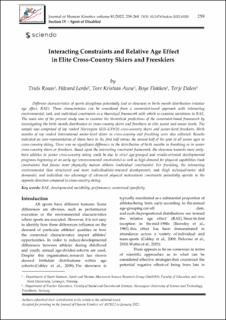| dc.contributor.author | Roaas, Truls | |
| dc.contributor.author | Lorås, Håvard | |
| dc.contributor.author | Aune, Tore Kristian | |
| dc.contributor.author | Flakken, Boye | |
| dc.contributor.author | Dalen, Terje | |
| dc.date.accessioned | 2022-12-06T07:14:28Z | |
| dc.date.available | 2022-12-06T07:14:28Z | |
| dc.date.created | 2022-02-01T20:41:39Z | |
| dc.date.issued | 2022 | |
| dc.identifier.citation | Journal of Human Kinetics. 2022, 81 259-268. | en_US |
| dc.identifier.issn | 1640-5544 | |
| dc.identifier.uri | https://hdl.handle.net/11250/3035942 | |
| dc.description.abstract | Different characteristics of sports disciplines potentially lead to skewness in birth month distribution (relative age effect, RAE). These characteristics can be considered from a constraint-based approach with interacting environmental, task, and individual constraints as a theoretical framework with which to examine variations in RAE. The main aim of the present study was to examine the theoretical predictions of the constraint-based framework by investigating the birth month distribution in cross-country skiers and freeskiers at elite junior and senior levels. The sample was comprised of top ranked Norwegian U15–U19/20 cross-country skiers and junior-level freeskiers. Birth months of top ranked international senior-level skiers in cross-country and freeskiing were also collected. Results indicated an over-representation of skiers born in the first half versus the second half of the year at all junior ages in cross-country skiing. There was no significant difference in the distribution of birth months in freeskiing or in senior cross-country skiers or freeskiers. Based upon the interacting constraint framework, the skewness towards more early-born athletes in junior cross-country skiing could be due to strict age-grouped and results-oriented developmental programs beginning at an early age (environmental constraints) as well as high-demand for physical capabilities (task constraints) that favour more physically mature athletes (individual constraints). For freeskiing, the interacting environmental (less structured and more individualistic-oriented development), task (high technical/motor skill demands), and individual (no advantage of advanced physical maturation) constraints potentially operate in the opposite direction compared to cross-country skiing. | en_US |
| dc.language.iso | eng | en_US |
| dc.publisher | Sciendo | en_US |
| dc.rights | Navngivelse 4.0 Internasjonal | * |
| dc.rights.uri | http://creativecommons.org/licenses/by/4.0/deed.no | * |
| dc.title | Interacting Constraints and Relative Age Effect in Elite Cross-Country Skiers and Freeskiers | en_US |
| dc.title.alternative | Interacting Constraints and Relative Age Effect in Elite Cross-Country Skiers and Freeskiers | en_US |
| dc.type | Peer reviewed | en_US |
| dc.type | Journal article | en_US |
| dc.description.version | publishedVersion | en_US |
| dc.source.pagenumber | 259-268 | en_US |
| dc.source.volume | 81 | en_US |
| dc.source.journal | Journal of Human Kinetics | en_US |
| dc.identifier.doi | 10.2478/hukin-2022-0020 | |
| dc.identifier.cristin | 1996646 | |
| cristin.ispublished | true | |
| cristin.fulltext | original | |
| cristin.qualitycode | 1 | |

